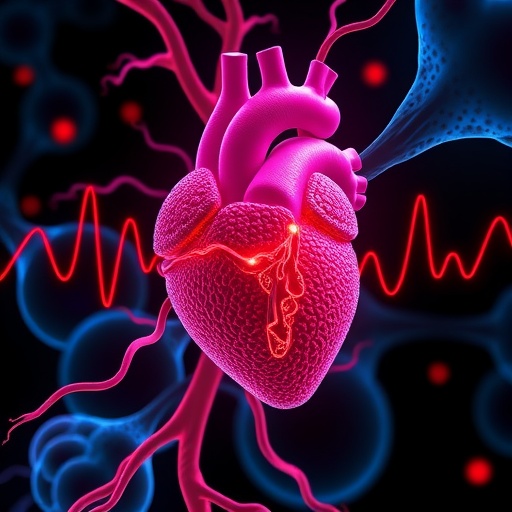In a groundbreaking study published in Nature Neuroscience, researchers have unveiled a novel neural mechanism through which oxytocin—the hormone famously associated with social bonding and emotional regulation—directly modulates the autonomic control of heart rate variability in synchrony with respiratory cycles. This discovery not only deepens our understanding of the multifaceted roles of oxytocin but also paves the way for innovative therapeutic strategies aimed at cardiovascular and stress-related disorders.
Historically, oxytocin has been predominantly recognized for its peripheral effects on uterine contractions and lactation, as well as its central role in social behavior and emotional processing. However, the study by Buron et al. extends the landscape of oxytocin’s influence to the intricate coordination between respiratory rhythms and autonomic cardiac function. Heart rate variability (HRV), a well-established marker of autonomic nervous system adaptability and cardiovascular health, is intricately tied to respiratory cycles—a phenomenon known as respiratory sinus arrhythmia (RSA). Understanding how oxytocin modulates this relationship is crucial, given the implications for stress resilience and emotional regulation.
The research team employed a sophisticated approach combining neuronal tracing, optogenetics, electrophysiology, and pharmacology to trace and manipulate a discrete neuronal circuit linking the hypothalamus, brainstem nuclei, and cardiac function. Central to their findings is the paraventricular nucleus (PVN) of the hypothalamus, a brain region rich in oxytocinergic neurons. These PVN neurons project directly to critical brainstem areas, including the nucleus tractus solitarius (NTS) and the dorsal motor nucleus of the vagus (DMV), both pivotal in autonomic cardiorespiratory control.
Through targeted optogenetic activation of PVN oxytocin neurons in animal models, the researchers demonstrated enhanced respiratory-linked heart rate variability, signifying an increase in parasympathetic tone to the heart. This effect was abrogated by selective oxytocin receptor antagonism in the brainstem, confirming the specificity of oxytocinergic modulation within this circuit. Additionally, recordings of neuronal activity revealed that oxytocin released in the brainstem potentiates vagal output to the sinoatrial node, thereby finely tuning the heart rate in synchrony with inhalation and exhalation phases.
The team’s electrophysiological data further illuminated the cellular mechanisms underlying oxytocin’s influence. Oxytocin increased the excitability of brainstem parasympathetic neurons by modulating ion channel activity, contributing to an enhanced rhythmic vagal firing pattern that corresponded to respiratory cycles. This mechanism explains how oxytocinergic signaling can dynamically adjust autonomic output to optimize cardiovascular function in real-time, reflecting the organism’s changing physiological and environmental demands.
Remarkably, the study underscores the bidirectional nature of the hypothalamus–brainstem–heart pathway. While the PVN exerts top-down control over cardiac function, sensory feedback from pulmonary stretch receptors and baroreceptors converges on brainstem nuclei, influencing oxytocin neuron activity via ascending pathways. This feedback loop ensures coherent integration of respiratory and cardiovascular signals to maintain homeostasis, particularly during stress or emotional arousal, when both heart rate and breathing patterns undergo complex modulation.
Importantly, these findings have profound clinical implications. Heart rate variability is a critical biomarker in numerous pathological conditions, including anxiety disorders, depression, heart failure, and hypertension. The ability to modulate respiratory-linked HRV through oxytocinergic circuits suggests new avenues for treatment. The potential for pharmacological or neuromodulatory interventions targeting this pathway could revolutionize therapies for patients with autonomic dysregulation or impaired stress coping mechanisms.
In the broader context of neurocardiology, this study adds a compelling layer of understanding to how neuropeptides like oxytocin integrate central nervous system functions with peripheral physiological parameters. Traditionally separated domains of emotional neuroscience and cardiovascular physiology are now being bridged by these insights, illustrating the complexity and sophistication of neurohumoral regulatory systems.
Furthermore, this oxytocin-dependent pathway highlights evolutionary adaptations that facilitate social behavior and survival. In social mammals, synchronized breathing and heart rhythms during affiliative behaviors could optimize group cohesion and collective responses to environmental challenges. The coupling of respiratory and cardiac rhythms by neuropeptides may therefore serve as a fundamental biological substrate for social bonding and communication.
Methodologically, the authors’ use of cutting-edge viral tracing methods to delineate specific neuronal projections, combined with in vivo optogenetic manipulation, represents a tour de force in systems neuroscience. Such integrative approaches are crucial for disentangling the complex circuitry underlying autonomic control and for identifying precise targets for modulation.
Moreover, the study emphasizes the role of neuromodulators in shaping autonomic nervous system plasticity, shifting the paradigms from rigid reflex arcs to flexible networks capable of adapting to both internal and external stimuli. Oxytocin’s modulatory effects on parasympathetic output exemplify this dynamic adaptability, positioning this neuropeptide as a key player in health and disease.
Looking ahead, future research may explore how other neuropeptides or neurotransmitter systems interact with oxytocinergic circuits to synergistically influence heart rate variability and respiratory function. Additionally, translating these findings to humans will be crucial, potentially involving non-invasive brain stimulation or intranasal oxytocin administration to evaluate cardiovascular and emotional outcomes.
In summary, the revelation of a hypothalamus-to-brainstem oxytocinergic pathway fine-tuning respiratory-driven cardiac vagal activity represents a seminal advance in our comprehension of neurocardiac integration. It underscores the exquisite precision with which the central nervous system orchestrates autonomic function and opens exciting prospects for therapeutics targeting the interface between emotion, respiration, and cardiovascular health.
This pioneering study by Buron, Linossier, Gestreau, and colleagues serves as a beacon for interdisciplinary inquiry, melding neuroendocrinology, cardiovascular physiology, and behavioral neuroscience into a cohesive framework. As we continue to unravel the mysteries of the brain-heart axis, such discoveries illuminate not only the biological underpinnings of vital functions but also the profound interconnectedness of mind and body.
Subject of Research: Neural mechanisms by which oxytocin modulates respiratory-related heart rate variability through a hypothalamus-brainstem-heart pathway.
Article Title: Oxytocin modulates respiratory heart rate variability through a hypothalamus–brainstem–heart neuronal pathway.
Article References:
Buron, J., Linossier, A., Gestreau, C. et al. Oxytocin modulates respiratory heart rate variability through a hypothalamus–brainstem–heart neuronal pathway. Nat Neurosci (2025). https://doi.org/10.1038/s41593-025-02074-2
Image Credits: AI Generated




